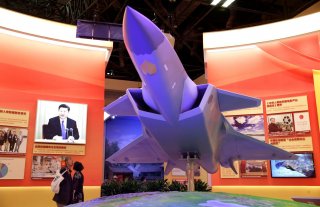Why China's J-20 Stealth Fighter Can't Compete with the F-35 or F-22
There simply is not enough of them.
While debates and uncertainties continue to swirl around how agile, lethal, stealthy and advanced China’s J-20 stealth fighter may be, the country may simply have another challenge crippling its ability to rival the F-22 and F-35: There simply are not enough J-20s.
Several interesting reports cite production problems and delays with J-20 manufacturing, particularly centered around the J-20’s “high-thrust turbofan WS-15 engine.” A report from the South China Morning Post says J-20 engine work has “fallen behind schedule,” and that China was “thought to have built about 50 J-20s by the end of 2019, but problems with the jets engines delayed production plans.”
If China has in fact produced 50 of its highly touted J-20, that still falls way short of the U.S.’ current fleet of ready and armed 5th Gen fighters. Lockheed statements given to The National Interest report that the firm has built and delivered 195 F-22s, with 186 of them combat ready. Made by Lockheed Martin and Boeing, the F-22 uses two Pratt & Whitney F119-PW-100 turbofan engines with afterburners and two-dimensional thrust vectoring nozzles, an Air Force statement said. It is 16-feet tall, 62-feet long and weighs 43,340 pounds. Its maximum take-off weight is 83,500; there is much interesting discussion comparing F-35 and F-22 engine thrust to China’s J-20 engine.
As for the F-35, available Lockheed data says it delivered its 134th F-35 last year and, at least prior to COVID-19, planned to deliver as many as 141 F-35s this year. The coronavirus, however, has impacted supply chain and production progress with the F-35, and Lockheed officials recently told Air Force Magazine that they expect to decrease aircraft production by 18-to-24 jets.
Lockheed’s statement from December of last year says:
“The 134th aircraft is a Short Takeoff and Vertical Landing (STOVL) model for the United States Marine Corps. In 2019, deliveries included 81 F-35s for the United States, 30 for international partner nations and 23 for Foreign Military Sales customers.”
Of course it is not yet clear just how many J-20s China will build, or how fast they plan to build them. Nonetheless, slower or smaller scale J-20 production by no means erases or largely minimizes the growing threat presented by China’s Air Force.
Overall, the U.S. Air Force’s technological airpower superiority over China is rapidly diminishing in light of rapid Chinese modernization of fighter jets, missiles, air-to-air weapons, cargo planes and stealth aircraft, according to a Congressional review released several years ago.
The 2014 U.S.-China Economic and Security Review Commission recommended that Congress appoint an outside panel of experts to assess the U.S.-Chinese military balance and make recommendations regarding U.S. military plans and budgets, among other things. Despite being released in 2014, the findings of the report offer a detailed and insightful window into Chinese Air Force technology, progress and development.
The Commission compiled its report based upon testimony, various reports and analytical assessments along with available open-source information. An entire chapter is dedicated to Chinese military modernization.
The review states that the Chinese People’s Liberation Army had, as of 2014, approximately 2,200 operational aircraft, nearly 600 of which are considered modern.
“In the early 1990s, Beijing began a comprehensive modernization program to upgrade the PLA Air Force from a short-range, defensively oriented force with limited capabilities into a modern, multi-role force capable of projecting precision airpower beyond China’s borders, conducting air and missile defense and providing early warning,” the review writes.
Alongside the J-20, the Congressional report also cites Chinese prototyping of its stealthy J-31 and a host of other fast-modernizing aircraft presenting threats to the U.S. Air Force.
Alongside their J-10 and J-11 fighters, the Chinese also own Russian-built Su-27s and Su-30s and are on the verge of buying the new Su-35 from Russia at the time of the report, the review states.
“The Su-35 is a versatile, highly capable aircraft that would offer significantly improved range and fuel capacity over China’s current fighters. The aircraft thus would strengthen China’s ability to conduct air superiority missions in the Taiwan Strait, East China Sea, and South China Sea as well as provide China with the opportunity to reverse engineer the fighter’s component parts, including its advanced radar and engines, for integration into China’s current and future indigenous fighters,” the review writes.
In fact, this ambition did come to fruition, according to a May 1, 2020 report from The National Interest which states China has already bought as many as 24 Su-35s.
Finally, Chinese threats are by no means limited to the speed, range and maneuverability of the jets themselves, but the increasingly modern weapons they fire.
“All of China’s fighters in 2000, with the potential exception of a few modified Su-27s, were limited to within-visual-range missiles. China over the last 15 years also has acquired a number of sophisticated short and medium-range air-to-air missiles; precision-guided munitions including all-weather, satellite-guided bombs, anti-radiation missiles, and laser-guided bombs; and long-range, advanced air-launched land-attack cruise missiles and anti-ship cruise missiles,” the review says.
Kris Osborn is the new Defense Editor for the National Interest. Osborn previously served at the Pentagon as a Highly Qualified Expert with the Office of the Assistant Secretary of the Army—Acquisition, Logistics & Technology. Osborn has also worked as an anchor and on-air military specialist at national TV networks. He has appeared as a guest military expert on Fox News, MSNBC, The Military Channel, and The History Channel. He also has a Masters Degree in Comparative Literature from Columbia University.
Image: Reuters

